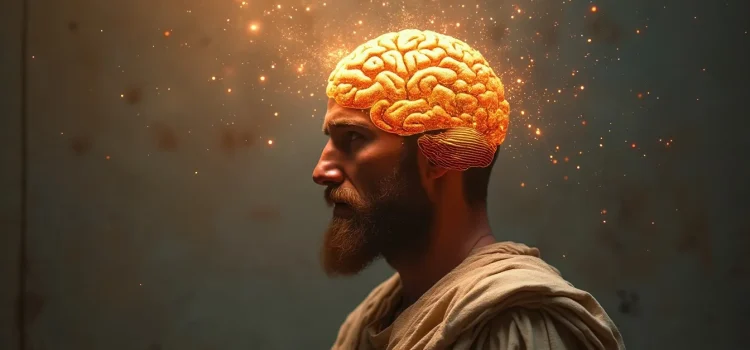
What did people’s minds feel like before the development of human consciousness as we know it? How did our ancestors interpret the thoughts in their heads?
Julian Jaynes’s bicameral mind theory suggests that consciousness as we know it emerged only around 3,000 years ago, replacing an earlier mental structure. Jaynes proposes that humans once possessed a “bicameral mind,” where one part of the mind seemed to speak while the other listened and obeyed.
Keep reading to learn the core principles of this theory and the questions it might answer.
Julian Jaynes’s Bicameral Mind Theory: Core Principles
Julian Jaynes’s bicameral mind theory proposes that human consciousness—our awareness of ourselves as individuals with thoughts, emotions, memories, and perceptions—isn’t something we’ve always had. First, we had a mental state he calls the “bicameral mind.”
The word “bicameral” means “two chambers.” While the physical brain also has two halves, called hemispheres, Jaynes is talking about the mind. (Shortform note: What’s the difference between the brain and the mind? Neuroscientists characterize the mind as a stream of conscious and unconscious mental activity—thinking, feeling, and choosing—and the brain as a physical organ that generates and responds to the mind’s activity. The brain enables conscious experience. But we experience our minds as a separate kind of “aliveness” that drives the brain’s activity.)
Jaynes explains that, for humans with a bicameral mental structure, one half of the mind seemed to speak, and the other listened and obeyed. This gave people the impression that they were hearing the voice of a god or an ancestor telling them what to do.
(Shortform note: While Jaynes uses the concept of “two chambers” metaphorically to describe mental organization, research on split-brain patients has revealed insights about actual division in the brain. When neurosurgeons cut the corpus callosum—the bundle of neural fibers connecting the brain’s hemispheres—to treat severe epilepsy, they found that each half of the brain could function largely independently. But, unlike Jaynes’s concept of permanently separate mental “chambers,” these patients maintained a unified sense of self. This suggests that while our brain hemispheres can operate as two separate systems, they naturally work to create a single, coherent experience of consciousness.)
Consciousness is, in some ways, the opposite of the bicameral mind: Jaynes notes people with a bicameral mind didn’t have an awareness of themselves as individuals thinking their own unique thoughts and actively making their own decisions. He emphasizes that without consciousness, a person with a bicameral mind would function almost automatically, responding to the events around them without conscious thought. When they found themselves in a situation they’d never experienced before—like an accident or an unexpected obstacle—they wouldn’t consciously think about or rationalize what they should do. Instead, they’d hear a guiding voice, and they would follow its instructions.
As consciousness began to emerge, this changed. Instead of relying on a hallucinated voice to tell them what to do, people developed the ability to consciously describe their experiences, think through decisions for themselves, and explain their actions to themselves and others. What Jaynes calls the “breakdown” of the bicameral mind was a gradual transition from acting automatically on seemingly external instructions to a state of active reflection, self-awareness, and conscious thought and reason. Jaynes uses the phrase “the breakdown of the bicameral mind” to suggest that consciousness only came about after this earlier mental structure failed to keep up with human needs and needed to be replaced.
(Shortform note: Other scholars join Jaynes in thinking consciousness emerged gradually. What came before consciousness? Was it the bicameral mind? Nobody really knows. Yet some anthropologists suggest our prehistoric ancestors experienced a more primal state of awareness closely tied to the natural world and orally shared knowledge. Kim Stanley Robinson’s novel Shaman imagines what this pre-conscious existence may have been like: a struggle to survive a harsh environment and maintain cultural continuity through storytelling. Experts think certain stories, phrases, and practices persisted for thousands of years this way before writing radically changed consciousness.)
| What Makes a Theory a Theory? Is Jaynes’s theory really a theory in the same sense as Darwin’s theory of evolution or Einstein’s theory of general relativity? A scientific theory is a comprehensive explanation of a phenomenon, supported by evidence. It enables scientists to make predictions. But a theory is constantly weighed against new observations: While it incorporates and explains multiple facts and hypotheses, it remains open to testing and revision. Jaynes’s paradigm is a bit more like a hypothesis rather than a full-fledged theory since it’s largely untested against archaeological and anthropological data on human cognition. But he cites several lines of evidence that he believes support his beliefs about how we evolved conscious awareness. Literary evidence: Jaynes analyzes ancient texts, particularly Homer’s Iliad and Odyssey, arguing that the former shows characters lacking introspection and being guided by gods, while the latter shows the emergence of inner mental states. Archaeological evidence: He points to the prevalence of idols and “god-kings” in early civilizations as evidence of the bicameral mind, and their gradual disappearance as evidence of the transition to consciousness. Linguistic evidence: Jaynes examines the development of words for mental states and consciousness in various languages, arguing that these concepts emerged relatively late. Neurological evidence: He discusses the differences in function between the brain’s hemispheres, suggesting that the right hemisphere’s role in generating language could have been the source of the “voices” in the bicameral mind. Psychological evidence: Jaynes draws parallels between bicameral mentality and certain aspects of hypnosis, possession states, and schizophrenia. |
Consciousness is tricky to define. The word usually refers to a state of being aware of yourself and your existence in the world. Jaynes emphasizes that consciousness is more than simple sensory awareness: It’s the experience of having a “self” who can reflect on and make sense of what you experience. Consciousness involves self-awareness, reflective thought, and an ability to make decisions based on mental processes we experience as internal rather than external. So, instead of being guided by a voice that seems like it comes from outside of us, we can reflect, reason, and decide based on our thoughts and our interpretations of the world around us.
(Shortform note: Many experts agree with Jaynes that the experience of consciousness involves an awareness of our thoughts, feelings, memories, and sensations. But neuroscientists say their theories can’t yet fully explain what gives rise to that subjective experience of consciousness. In other words, many theories describe the neural conditions associated with consciousness, but they don’t bridge the “explanatory gap” between the physical processes occurring in the brain and the first-person experience of being conscious that we have in our minds. This gap is what makes consciousness so tricky to define (or, in philosophers’ parlance, “a hard problem.”))
According to Jaynes, consciousness is more than just the passive ability to reflect on things that have happened to you. It also involves the active process of interpreting and organizing information. Jaynes argues that this type of introspective consciousness—which we take for granted today—didn’t exist for early humans. Jaynes’s theory about consciousness and how it came about rests on three key ideas: that consciousness emerged only recently, that early humans’ minds were organized very differently than ours, and that the cognitive demands of a complex social world led us to develop consciousness as a replacement for the bicameral mind.
1. Consciousness Is a Relatively Recent Phenomenon
The first core idea of Jaynes’s theory is that consciousness didn’t emerge until 1,000 BCE—just 3,000 years ago. This creates an apparent paradox: By this point in history, humans had already built sophisticated civilizations, developed writing systems, and created complex social structures. How could they have accomplished this without consciousness?
Jaynes’s answer is that early humans possessed a different kind of mind—what he calls the “bicameral mind”—that enabled them to build civilizations without the kind of self-aware consciousness we experience today. He argues that people with a bicameral mind could follow complex commands, maintain social hierarchies, and perform sophisticated tasks through what he describes as a more automated, less self-aware form of cognition. In his view, it wasn’t until massive social and cultural changes around 1000 BCE—including rising literacy rates and new ways of thinking—that humans developed the kind of introspective consciousness we now take for granted.
(Shortform note: Archaeological evidence poses significant challenges to Jaynes’s timeline. Sites like Göbekli Tepe in Turkey, dating to the 10th millennium BCE, suggest advanced civilization existed much earlier than Jaynes proposes. Moreover, evidence of human capabilities like art, adornment, and language—which seem to require self-awareness and conscious thought—dates back tens of thousands of years. Many experts find it difficult to accept that humans could have created such sophisticated cultural practices without the kind of conscious awareness Jaynes claims emerged much later.)
To support his theory that humans weren’t conscious until very recently in our evolution, Jaynes draws on evidence from ancient literature, religious practices, and cultural artifacts. His most famous example is Homer’s The Iliad: He argues that the characters’ lack of introspection and their experience of divine voices as guidance shows that even in ancient Greece, people still had a bicameral rather than a conscious mind. However, critics argue that literary conventions, rather than cognitive differences, explain these narrative characteristics.
| Did Jaynes Have Proof for His Theory? While Jaynes drew on an impressive range of cultural and literary evidence, he lacked empirical neurological or psychological proof for his theory. He acknowledged these limitations and the inherent paradox of trying to investigate and describe consciousness through the lens of a conscious mind. Scholars note that Jaynes recognized his book was just a rough beginning, and he planned to write a sequel called The Consequences of Consciousness—though this book never materialized. Over time, Jaynes simplified rather than expanded his theory, almost apologizing for his early audacity. Though Jaynes’s thesis is considered scientifically fringe, broader insights from his work—like the idea that language played a crucial part in pushing us toward consciousness—have influenced other thinkers. Experts ranging from philosopher Daniel Dennett (Darwin’s Dangerous Idea) to neuroscientist Antonio Damasio (Feeling & Knowing) have said they’re intrigued by Jaynes’s ideas. Dennett appreciates the distinction Jaynes proposes between human consciousness and animal consciousness and his idea that the difference might be rooted in the uniqueness of human language. Damasio agrees with Jaynes that accumulated knowledge could have altered human self-awareness and mental processing over time. However, subsequent discoveries about consciousness in animals have undermined some of Jaynes’s specific claims. Evidence shows that many animals—from crows and whales to octopuses and bees—display behaviors suggesting rudimentary consciousness, including tool use, deception, learning, memory, and social communication. These findings challenge Jaynes’s view that consciousness is uniquely human and emerged only recently. |
2. The Bicameral Mind Differed From the Conscious Mind We Have Today
Having presented his timeline for the emergence of consciousness, Jaynes turns to explaining exactly how pre-conscious humans thought and behaved. The second core idea of his theory describes how the bicameral mind operated. According to Jaynes, this ancient form of cognition was fundamentally different from our modern conscious awareness. Rather than experiencing themselves as individuals making conscious choices, people with bicameral minds received guidance through what they perceived as auditory hallucinations—voices they typically interpreted as coming from gods, rulers, or ancestors.
But how did this mental organization function in practice? Jaynes explains that, for someone with a bicameral mind, cognitive processes were split between the brain’s hemispheres. As in modern humans, the brain had right and left hemispheres. He theorizes that the right temporal lobe generated auditory hallucinations, which were then transmitted to and perceived by the left (or dominant) hemisphere. While both halves of the brain were connected and communicated with each other, they didn’t work together in the integrated way our modern brains do.
Jaynes writes that this mental organization was remarkably effective for its time: The bicameral mind enabled people to make plans and decisions, skills crucial for human survival and development. But these mental processes didn’t feel like they belonged to the individual—because people with a bicameral mind lacked the introspective awareness and sense of self that characterize our modern consciousness. Even though their brains looked physically similar to ours, their minds weren’t organized in a way that allowed for self-reflection or awareness of their own thinking.
3. The Complexity of the Social World Forced People to Move Beyond the Bicameral Mind
While this mental organization served early human societies effectively, Jaynes argues that the bicameral mind eventually proved inadequate for an increasingly complex world. As societies evolved beyond rigid hierarchies, they faced new challenges: population growth, trade networks that exposed people to diverse beliefs and practices, invasions and natural disasters that disrupted established patterns, and—perhaps most significantly—the invention of writing. The third core idea of Jaynes’s theory is that these mounting pressures demanded more sophisticated ways of processing information and making decisions than the bicameral mind could provide.
Jaynes contends that writing, in particular, catalyzed the breakdown of the bicameral mind. When messages that had previously been experienced as auditory hallucinations could be written down, they became visible, permanent, and—crucially—controllable. People could now access and interpret information independently, rather than relying on hallucinated voices for guidance. As written communication became more prevalent, people gradually relied less on the auditory hallucinations generated by the right hemisphere of their brains. The voices of the “gods” lost their commanding influence, becoming less effective at directing behavior until they eventually faded away.
The shift away from the bicameral mind created a fundamental change in how humans experienced their world. As the hallucinated voices became less reliable guides—particularly during times of social chaos when different “gods” might give conflicting instructions—people needed a new way to organize their mental processes. The solution that emerged was consciousness: an internal representation of the self that could create coherent narratives from experience and make independent decisions. This new mental faculty enabled people to reflect on their choices, imagine different possible futures, and take responsibility for their actions.
Jaynes explains that the shift toward consciousness wasn’t instantaneous but gradual, likely accelerating during periods of social upheaval when traditional ways of thinking proved insufficient. As people learned to rely on their own judgment rather than divine guidance, they developed new capabilities for self-reflection, abstract thinking, and decision-making—the hallmarks of consciousness as we know it today.
Why Is Jaynes’s Theory Still Studied?
Jaynes’s idea of how our modern way of thinking and relating to the world emerged represents a major break with conventional views. Yet the theory also suggests potential answers to longstanding questions about human cognition and evolution.
Why Do Humans Tend to Develop Religious Beliefs?
First, Jaynes’s theory may explain why human societies tend to develop religious beliefs and rituals. Based primarily on his analysis of ancient texts and cultural practices, Jaynes hypothesizes that early humans regularly experienced what he interprets as auditory hallucinations that they perceived as the voices of gods. While he lacks direct neurological evidence for these hallucinations, he argues that if this hypothesis is correct, it would explain the ubiquity of religion across cultures. His theory suggests that as these voices began to fade, finding ways to replace them became a near-universal instinct. That led to the rise of organized religions and spiritual belief systems, which fulfilled people’s desire for guidance and meaning in an increasingly uncertain world.
Jaynes also proposes that the hypothetical fading of these voices could explain why many cultures shifted from polytheism to monotheism. He suggests that as the conflicting guidance from multiple gods became inadequate, the voices of these gods became less prominent. But people still wanted divine guidance. Jaynes argues it would have been natural for people to develop ideas of a single god, paralleling the shift from the many voices of the bicameral mind to the single voice of a person’s own.
(Shortform note: While Jaynes theorizes that monotheistic religion arose naturally in humans to replace our fading hallucinations of divine voices, some historians suggest the prevalence of atheism in ancient societies contradicts the idea that we have an innate predisposition for religious belief. In Battling the Gods, Tim Whitmarsh writes that a lack of belief in deities was more widespread in ancient polytheistic societies than we assume. The diversity of polytheistic Greek city-states enabled the proliferation of atheist philosophies, since these societies lacked centralized religious authority. In fact, Whitmarsh says they were more accommodating of atheism than many later cultures dominated by monotheistic imperial regimes.)
Why Do Complex Societies Seem to Emerge Suddenly in the Historical Record?
Second, Jaynes’s theory offers an explanation for the observation by anthropologists that sophisticated civilizations seemed to appear abruptly in the historical record. He contends that the bicameral mind enabled early humans to build increasingly complex societies without the need for introspective consciousness as we understand it. As these societies grew more sophisticated—developing writing, trade networks, and complex social structures—the bicameral mind proved inadequate for handling these new challenges, leading to the emergence of consciousness around 3,000 years ago.
(Shortform note: While Jaynes sees the complexity of early civilizations as driving the development of consciousness, anthropologists suggest other factors influenced this historical transition. A global climatic shift around 10,000 years ago may have created conditions more suitable for the rise of agriculture and stationary settlements. Those settlements, in turn, enabled the independent development of literate civilizations in different parts of the world within a relatively short timeframe. A warming climate could have acted as a catalyst, allowing societies in regions like Mesopotamia, China, and Central America to transition from hunter-gatherer subsistence to more advanced organization within a few thousand years.)
Why Do We Struggle With Decision-Making?
Finally, Jaynes’s theory may explain why humans are bad at making rational decisions. Jaynes argues this difficulty might stem from the recent loss of the clear, authoritative voices that once guided our behavior. He contends the process of decision-making relies on unconscious judgments more than it does on conscious thought. And while the bicameral mind was good at telling us to act on the decisions that our subconscious made, we lost that easy connection with our decision-making processes when we became conscious.
(Shortform note: Our trouble with rational decision-making is the subject of study for many psychologists, who have identified some of the mechanisms that cause us to struggle. They say our perception of reality can become distorted by high anxiety or the prospect of major rewards, causing us to act in ways that seem reasonable to us but foolish to others. This distortion happens subconsciously through neurobiological processes that alter how our brains process information, independent of our intelligence or morals. Furthermore, in high-pressure situations involving fear or potential gains, the brain’s reward centers get activated, changing our perceptions to align with the desired outcome despite contradictory evidence.)
Whether Jaynes’s paradigm of the bicameral mind is correct or incorrect in explaining how we ended up with the minds (and brains) we have today, it nonetheless addresses important questions. If consciousness emerged from cultural development rather than as an evolved biological trait, that suggests our current consciousness isn’t the only one of which our brains (and minds) are capable. This opens questions about how consciousness might continue to evolve and whether we might be able to access alternative forms of consciousness that we’ve yet to discover or develop.
(Shortform note: Like Jaynes, some philosophers suggest that if consciousness emerged as a cultural invention, it might continue to evolve into new forms. They also think that artificial intelligence systems with metaphorical capabilities could potentially develop consciousness, given Jaynes’s perspective that consciousness arose through the human capacity for metaphor and analogy.)






